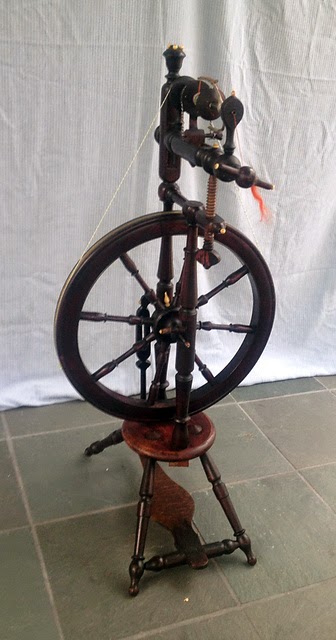Over the last two years of collecting and restoring spinning wheels, I've developed a particular affection for wheels that have been languishing in storage. I've also got a soft spot for wheels that use metal in unusual places. So this wheel, which appeared last month on eBay in Germany, hit all my buttons. The seller told me he found it in his grandmother's house and estimated she had worked with it 60 years ago.
It was slathered with a layer of paint in an unfortunate shade of brown, and the metal parts were pretty dark, pitted in a few spots and rusted in others due to corrosion. The wheel was packed in a box that was too small, and a hit on the back leg cracked the table while it was in transit. My heart sank when I first unpacked it, thinking it was too far gone to rehabilitate.
Over the course of the following weekend, I started to clean up the metal, using a scrub pad and a solution of vinegar and cream of tartar on the aluminum parts. Generous use of sewing machine oil and the wire brush attachment on my Dremel did the rest to get the metal flyer assembly spiffed up. Stripping off the paint revealed lovely wood which came back to life with a coat of Danish oil and a follow-up of Howard's Feed and Wax.
The flyer is quite dainty with a tiny orifice. It sits in bearings made of wood within the aluminum maidens. Tiny wire hooks slide in channels on each arm of the flyer.
The drive band is tensioned with a screw post that raises the MOA up and down.
I have seen photos of four others of these wheels on Pinterest. They all source back to eBay Germany except one which traces back to eBay France. One Pinterest description states the wheel is from the 1950's, another says 1948.
After the first big effort to get this sturdy little wheel cleaned up and running, it came back into spinning condition very easily. It treadles smoothly and is practically silent. The size of the orifice suggests that it was made to spin very fine, and I was interested to see that one of the photos from Pinterest shows a sibling wheel set up to spin in triple drive, where the drive band makes three loops from the drive wheel to the flyer assembly. I'm running it in double drive right now, which is far more common, but I'm looking forward to exploring the capabilities of this sweet little spinner!
The flyer is quite dainty with a tiny orifice. It sits in bearings made of wood within the aluminum maidens. Tiny wire hooks slide in channels on each arm of the flyer.
The drive band is tensioned with a screw post that raises the MOA up and down.
I have seen photos of four others of these wheels on Pinterest. They all source back to eBay Germany except one which traces back to eBay France. One Pinterest description states the wheel is from the 1950's, another says 1948.
After the first big effort to get this sturdy little wheel cleaned up and running, it came back into spinning condition very easily. It treadles smoothly and is practically silent. The size of the orifice suggests that it was made to spin very fine, and I was interested to see that one of the photos from Pinterest shows a sibling wheel set up to spin in triple drive, where the drive band makes three loops from the drive wheel to the flyer assembly. I'm running it in double drive right now, which is far more common, but I'm looking forward to exploring the capabilities of this sweet little spinner!
































